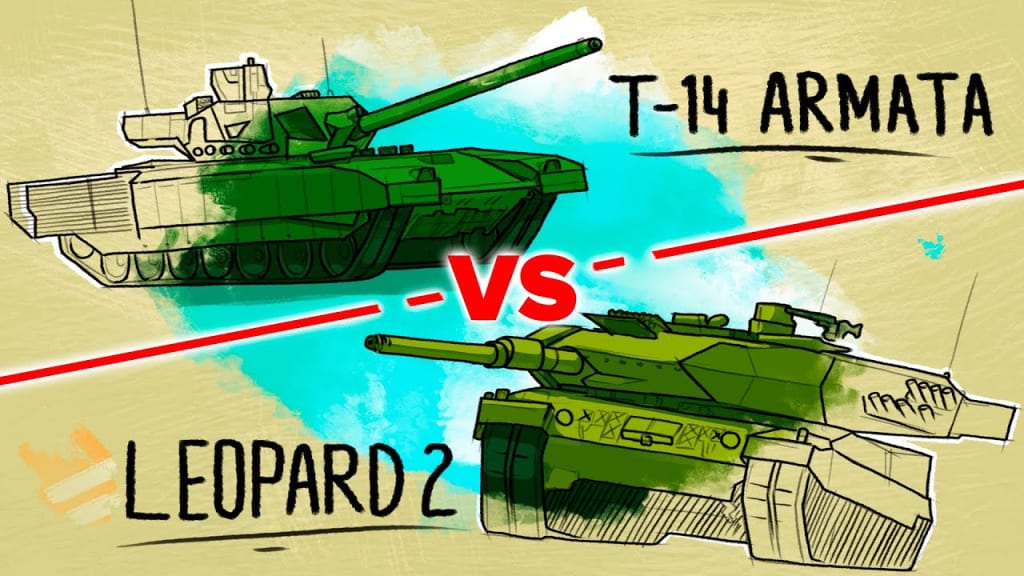Leopard 2 Vs. T-14 Armata (Tank War in Ukraine)
With the conflict in Ukraine escalating, it appears that Europe will finally provide Ukraine with the tanks it desires. But does this imply that the Leopard 2 will be able to compete with Russia's newest and greatest, the T-14 Armata? Then who would prevail if it happened? 🏴☠️💨💣💣💨🏴☠️

With the conflict in Ukraine escalating, it appears that Europe will finally provide Ukraine with the tanks it desires. But does this imply that the Leopard 2 will be able to compete with Russia's newest and greatest, the T-14 Armata? Then who would prevail if it happened? 🏴☠️💨💣💣💨🏴☠️
As the conflict in Ukraine escalates, it appears that Europe will finally provide Ukraine with the tanks it desires. But does this mean that the Leopard 2 might eventually face off against Russia's newest and greatest tank, the T-14 Armata, and if so, who would prevail? This is one of the issues that have come up due to the conflict in Ukraine in various circles: the applicability of tanks on a contemporary battlefield. These formidable machines once controlled the battlefield, but as the Ukrainian military has demonstrated with the aid of western anti-tank weapons, even the best tanks in the world are incredibly vulnerable to untrained infantry. Does that mean the tank is no longer useful? Not quite; it just means that tanks now need more infantry support than ever. And nothing can match the power of a tank when it comes to eliminating threats.
In a nutshell, nothing will do the job as well as a tank in a fight, so you won't really need one until you absolutely must have one. Germany appears likely to grant Ukraine's request for the export of its Leopard 2 heavy combat systems. This raises the possibility that the Leopard will finally engage Russia's best in combat, given unconfirmed reports of a small number of T-14 tanks crossing into Ukraine. If this occurs, we will finally learn whether the claims made about both tanks are accurate or merely lies. In response to advancements in Soviet armor development, the Leopard 2 began to take shape in the 1970s. The Germans were very interested in creating the best battle tank they could because West Germany would serve as ground zero—both metaphorically and literally—for any conflict between NATO and the Soviet bloc.
They were right on target, as the Leopard 2, an improvement over the Leopard 1, quickly rose to become one of the best tanks in the world and an unbeatable opponent for its Soviet adversaries. The MBT-70 was initially developed in partnership with the United States and West Germany. The US does a lot of things correctly when it comes to military hardware, but it has never really been at the top of the class when it comes to tanks. Additionally, the requirements for a main battle tank varied greatly between the two countries, and when combined with issues with communication between the two design bureaus, the project was doomed to failure. West Germany withdrew from the program as costs rose, and the US continued to work on it independently until it was eventually abandoned.
The US then used the lessons it had learned for the M1 Abrams. Instead, the German government investigated ways to improve the Leopard 1, with Porsche taking the initiative. According to the Gilded Leopard study, the Leopard 1 design could incorporate a number of cutting-edge technologies. The new tank would have an autoloader that would enable the use of heavier rounds, coaxial auto cannon, and an independent commander's periscope for situational awareness. Additional upgrades included an extendable TV security camera mounted on a mast, as well as changes to the engine, armor, and transmission. The Germans made a significant change by switching from a 105mm gun to a 120mm gun. This was in response to advancements in Soviet armor, which led the Americans to make a comparable change to their XM1—the Abrams prototype.
A Leopard 2 prototype was sent to the US by West Germany in 1976 so that American engineers could examine it. It was found that the two vehicles had comparable firepower and mobility to the XM1, but the XM1 had better armor protection. The Leopard 2 was nearly twice as protected against kinetic energy penetrators; however, this only applied to explosive charges. The Leopards engine was also more reliable, used less fuel, and produced less heat than the Leopards engine, but it made more noise. The Leopard 2's engine also made it possible for it to start up and shut down quickly, as opposed to the XM1, which required a lengthy startup process and was consequently forced to idle during brief intervals of combat. Shortly after the American tests, the Leopard 2 entered production, albeit with better armor. The most recent Leopard 2 now benefits from decades' worth of improvements, including more armor on the turret's front, the hull, and the side skirts.
According to estimates based on classified data, the Leopard 2 can withstand kinetic energy projectiles with a protection of up to 1840 millimeters and chemical explosive rounds with a protection of up to 2,780 millimeters. This protection is enhanced by the Leopard 2A6, which offers defenses that are equivalent to 5,890 mm to 7,800 mm of armor against kinetic penetrators and 9,000 mm to 11,500 mm of armor against chemical explosive rounds. Due to lessons learned from the wars in Iraq and Afghanistan, the belly armor has been improved to provide it with even more protection from enemy mines and IEDs. The crew is protected by spall liners inside the hull from the deadly effects of spalling, which happens when a projectile hits armor but does not penetrate it; instead, it causes the armor to fracture internally, sending razor-sharp metal shards bouncing around the interior of the tank.
This may result in the crew being killed but the tank remaining largely unharmed. Slat armor and active protection techniques also improve resistance to anti-tank missiles and rocket-propelled grenades. The Leopard 2's interior can be completely sealed off, giving the crew 12 hours of life support. This enables the tank to function on a nuclear battlefield. An automatic firefighting system can be activated by the driver or when the interior temperature reaches 180 degrees (82 degrees Celsius). Tanks are worthless without a gun, and the Leopard 2 excels in this regard. There are 27 rounds of ammo for the Rheinmetall 120mm smoothbore gun. On the left side of the turret bustle, the tank also has 15 extra rounds that are stored there and are accessible through a safe door. A blow-off panel, which is omitted in most Russian tanks, enables the ammunition to safely cook off without igniting the crew.
The German DM33 discarding sabot anti-tank round, which has a 2,000-meter range and can pierce steel armor up to 960 mm thick, is one of the many rounds that the Leopard 2 can fire. Germany has fielded an improved round that takes advantage of the bigger barrel with improved penetration. The new L55 cannon, which are being installed on upgraded Leopard 2s, have a longer barrel. The new barrel may also be able to fire the LAHAT anti-tank guided missile directly through the main gun, a capability found on some Russian tanks as well. The Leopard 2 builds upon a fantastic tank and enhances it over time with different upgrade packages, but the T-14 is built entirely from the ground up to house new technologies—could this be the competitive advantage? The T-14 was created as a result of the T-95's cancellation in 2010. The T-14 was a revolutionary advancement in tank design because it was decided that a completely new tank was required to meet and exceed NATO threats.
This is undoubtedly a tank for the modern era. The T-14 distinguishes itself right away from the Leopard 2 by housing its three crew members inside an armored capsule built right into the hull. While the commander of the Leopard sits in the turret, the crew of the T-14 sits side by side, leaving the turret unmanned and controlled remotely. As it lessens the commander's vulnerability, this is already a significant improvement over Leopard 2. Russian scientists created brand-new steel, 44S SV SH, for the armor of the tanks. This steel reportedly has very high durability and can withstand very high temperatures without deforming. It also has the added benefit of being 15 pounds lighter than the steel used in earlier tank models. The hull is also protected by a new composite armor that includes a classified ceramic layer, but the most ground-breaking element is the inclusion of explosive reactive armor in the base design itself as opposed to being added on later in the form of bricks.
The front, sides, and top of the Malachit are shielded from RPGs and anti-tank missiles by its dual-explosive reactive armor. However, modern tanks require active defenses, and the T-14 is equipped with the Afghanit active defense system. Both the hard-kill and soft-kill versions of APS are available. While soft kill systems, like laser dazzlers, aim to disrupt the guidance or electronics of an incoming munition, hard kill systems attempt to destroy or deform the munition with their own means. To target both incoming kinetic energy penetrators and tandem-charge weapons like the American Javelin, the Afghanit system, a first for the world, combines both. It does this using millimeter-wave radar. Despite claiming to protect the tank from all sides, the system is unable to deflect top-attack weapons, such as the American Javelin.
According to independent analysis, the system is believed to function with four sensor panels mounted on each of the tank's sides and a fifth panel possibly on the turret. These conceal active radar that tracks incoming projectiles using an electronically scanned array. While using its soft kill capabilities to obstruct the guidance system of anti-tank guided missiles, the system also has the ability to destroy projectiles like artillery shells and unguided rockets. The system is said to be effective against any current third- and fourth-generation anti-tank system, and the Russians assert that it can even defend against kinetic depleted uranium weapons like those used by American tanks. This claim has received a lot of skepticism, mainly because it was made by a Russian official, but also because an ultra-dense projectile traveling at a speed many times faster than the speed of sound could easily push the fragmentation charge in the active protection system out of the way.
At most, it might cause it to veer slightly off course, which simply means that it would ruin the tank's day in a location slightly away from the target. The system allegedly defeated uranium projectiles traveling at a speed of 2 km, according to the Russian MOD, which, as we have learned, never lies. However, this claim has not been independently verified. Additionally, the tank's manufacturer asserts that the T-14's inability to be detected by radar and infrared light is due to the placement of heat-generating components deep inside the hull of the tank and the use of radar-absorbing paint. The Armata is essentially a stealth vehicle thanks to the turret's shape, which also helps it reduce its radar and thermal heat signature. These claims have been debunked by both Russian and American experts, mainly because a Russian official made them and because Russia hasn't yet deployed any truly stealth platforms.
Russian pilots wouldn't be terrified to fly their aircraft over the front lines in Ukraine if Russia had invented a miraculous paint that defeated radar. The tank's 125mm smoothbore cannon allows it to fire Vacuum-1 rounds while discarding sabot fin stabilized rounds. This 900-millimeter-long projectile, which uses depleted uranium and can pierce 1,000 millimeters of armor at 2,000 meters, is still classified in detail. In keeping with Russian custom, the cannon is also capable of firing the 3UBK21 Sprinter ATGM, which has an increased range of up to 12 km, as well as the new 9M119M1 Invar-M anti-tank guided missile, which has a range of up to 5 km.






Comments
There are no comments for this story
Be the first to respond and start the conversation.